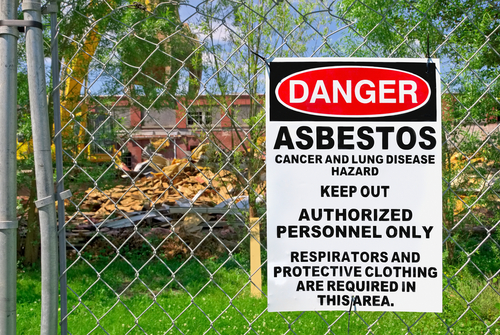Throughout the 1900s, asbestos products and building materials containing asbestos were used in the construction industry to create public buildings, offices, homes and other structures. Many homes, especially those built before 1980, may still contain asbestos materials. The list of asbestos products often found in homes is extensive and is discussed in one of our previous blog posts. It includes items like floor tiles and adhesives, ceiling tiles, textured paint, insulation, siding and much more.

If you suspect that your home contains products made with asbestos, how can you know for sure? In most cases, you cannot tell if a product contains asbestos just from looking at it unless it is labeled. If the age of your home and the type of product make you suspicious, but you are still unsure, treat the product as if it does contain asbestos.
Asbestos is dangerous if its fibers are disturbed and released into the air to be inhaled. If you suspect your home contains asbestos materials and one of the following situations applies to you, you may need to have your home inspected by a trained and accredited asbestos professional:
- You are planning to remodel your home in the near future (which would require disturbing/demolishing/removing building materials).
- Your home has been damaged and building materials are exposed (like crumbling drywall, broken floor tiles or insulation that is falling apart).
Asbestos Removal for Your Home
Proper and safe asbestos removal requires a trained and accredited asbestos professional. If you suspect the materials in your home are made with asbestos, and they are or will be exposed, disturbed, or damaged, the Environmental Protection Agency (EPA) has outlined the below steps for asbestos removal:
- Do not touch or disturb the asbestos materials.
- Limit access to the area.
- Contact a trained and accredited asbestos professional for repair and removal.
- Repair by an asbestos professional usually involves sealing (encapsulation) of the asbestos material with a sealant that binds the asbestos fibers so they cannot be released into the air, or covering (enclosure) of the material by placing something over or around the product to prevent the release of asbestos fibers.
- Removal is a complex process requiring protective gear and proper procedures that can only be conducted by a trained and accredited asbestos professional. Do not attempt to remove asbestos products yourself.
Further Asbestos Removal Information
Access other related topics about asbestos removal and asbestos exposure below:
Asbestos Exposure in Your Home
Asbestos Exposure in Debris
Asbestos Exposure in the Workplace
Asbestos Exposure in Schools
Mesothelioma Prevention: Tips for Avoiding Asbestos Exposure




